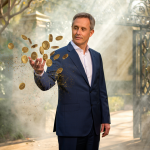
Nothing is more common on earth than to deceive and be deceived —
Johann G. Seume, 1763-1810, German theologist.
Financial Disaster Recovery Plan: Buy Low, Sell High
May 11, 2024
Introduction
Throughout history, financial markets have been prone to periods of turmoil and chaos, often leading to significant losses for the unprepared. However, within these moments of crisis lie opportunities for those with a strategic vision and a disciplined approach. In a financial disaster, the astute investor recognizes the potential for recovery and profit. This essay explores the concept of financial disaster recovery, drawing on the wisdom of ancient philosophers and modern financial experts to provide a comprehensive guide for navigating market crashes and emerging victorious on the other side.
Ancient Wisdom for Modern Financial Challenges
“Wealth is not an end, but a means to an end.” This profound insight from Aristotle highlights a crucial perspective for investors. Wealth is a tool, and financial disasters can be opportunities to reshape and rebuild one’s economic destiny. The ancient Greeks also emphasized the importance of moderation and prudence in financial matters, a concept known as “sophrosyne.” Excessive greed or fear can cloud judgment, leading to impulsive decisions. Socrates encouraged self-knowledge and understanding one’s limits, which is essential for developing a robust financial strategy.
The renowned Chinese philosopher Confucius offered similar wisdom: “Riches and honour are what people desire, but if they are obtained unlawfully, they will be harmful.” This underscores the importance of ethical practices and long-term sustainability in wealth accumulation. Financial disasters often expose the consequences of greed and unethical behaviour, providing a chance for a more robust and equitable system to emerge.
Understanding Market Dynamics: Corrections, Crashes, and Opportunities
Financial markets are inherently cyclical, alternating between periods of growth and decline. Corrections, or short-term price drops, are natural occurrences within a broader bull market. They serve as a reset, shaking off excessive speculation and reestablishing a foundation for sustainable growth. On the other hand, a market crash or a financial disaster signifies a more severe and prolonged downturn, often triggered by underlying economic imbalances or external shocks.
Famous investor and economist John Maynard Keynes likened the stock market to a beauty contest, where participants strive to predict which faces the judges will find most attractive. This analogy highlights the psychological and crowd dynamics at play in financial markets. Fear and panic can grip the market during an economic disaster, leading to a self-reinforcing downward spiral as investors rush to sell. However, within this chaos lies the opportunity to buy assets at discounted prices, setting the stage for future gains.
The Role of Central Banks and the Impact of Monetary Policy
Central banks, such as the Federal Reserve in the United States, play a pivotal role in shaping market dynamics and influencing the severity of financial disasters. By manipulating interest rates and employing various monetary tools, central banks can either exacerbate or mitigate the impact of a crisis. Lower interest rates can stimulate economic activity and encourage borrowing but also fuel speculative bubbles and excessive risk-taking.
Thomas Jefferson, the third president of the United States, warned of the dangers posed by bankers and the potential for them to manipulate the system for their benefit: “The Truth is that we can never satisfy their (bankers’) appetite for money.” Jefferson’s words ring true in today’s complex financial landscape, where central banks’ actions can have far-reaching consequences for investors and the broader economy.
Navigating the Storm: Strategies for Recovery and Profit
When facing a financial disaster, a well-prepared investor can implement strategies to recover losses and profit from the market turmoil. Here are some critical approaches:
Contrarian Investing: As Sun Tzu advised in “The Art of War,” “Appear where you are not expected.” When fear grips the market during a financial disaster, contrarian investors seek out undervalued assets that others neglect. This approach requires courage and a long-term perspective, as it often involves buying when others are selling.
Value Investing: Benjamin Graham, often considered the father of value investing, advocated for investing in companies trading below their intrinsic value. During a financial disaster, value investors seek out solid companies with strong fundamentals that may be temporarily undervalued due to market sentiment.
Technical Analysis and Market Timing: Chart patterns and technical indicators can provide valuable insights during financial disasters. Identifying support and resistance levels, recognizing chart patterns, and using technical tools can help investors time their entries and exit more effectively.
Diversification and Risk Management: Diversification is a critical strategy to manage risk during financial disasters. By allocating capital across various asset classes, sectors, and regions, investors can reduce their exposure to specific risks. Setting stop-loss orders and utilizing risk management techniques can also help limit potential losses.
Embracing Volatility: Financial disasters often bring heightened volatility. Investors who understand this can use volatility to their advantage, employing options trading, mean-reversion strategies, or investing in volatility-focused funds.
Learning from History: Past Financial Disasters and Their Lessons
History provides a treasure trove of knowledge and insights for investors. The Great Depression of the 1930s, the stock market crash of 1987, the Asian Financial Crisis of 1997, and the Global Financial Crisis of 2008 offer valuable lessons. These events had unique characteristics but shared common themes: excessive risk-taking, market euphoria, and the buildup of underlying vulnerabilities.
In 63 B.C., the ancient Roman statesman Cicero cautioned against financial excess and the importance of a balanced budget: “The budget should be balanced, the treasury should be refilled, and the public debt should be reduced.” Cicero’s words echo across the centuries, reminding us of the dangers of financial imprudence and the importance of fiscal responsibility, both on a personal and national level.
The Power of Patience and Long-Term Thinking
Financial disasters can test the resolve of even the most seasoned investors. During these challenging times, the value of patience and long-term thinking becomes evident. As the ancient Greek philosopher Epictetus taught, “The key is to keep company only with people who uplift you, whose presence calls forth your best.” Investing can be interpreted as holding onto quality investments and riding out the storm, trusting in the long-term potential of well-chosen assets.
The Role of Gold and Precious Metals in Disaster Recovery
Precious metals, particularly gold, have traditionally served as a safe haven during financial disasters. Gold’s intrinsic value and limited supply make it a reliable store of wealth and a hedge against inflation. As paper currencies lose value through central bank interventions, gold and other precious metals can provide a stable foundation for portfolios.
Planning for the Next Financial Disaster: A Proactive Approach
Financial disasters are inevitable in the economic cycle, and a proactive approach is essential. Here are some critical considerations for investors:
Emergency Funds and Liquidity: Building an emergency fund of readily accessible cash can provide a buffer during financial disasters, allowing you to meet essential expenses and avoid the forced selling of investments.
Diversification Across Asset Classes: Diversifying your portfolio across various asset classes, such as stocks, bonds, real estate, and commodities, helps reduce the impact of any single market crash.
Risk Management and Stop Losses: Disciplined risk management strategies, such as setting stop-loss orders, can limit potential losses and protect your capital.
Stay Informed and Adapt: Monitor market developments and economic indicators to identify potential risks and opportunities. Be prepared to adapt your strategy as market conditions change.
Embrace Volatility: Recognize that volatility creates opportunities. During financial disasters, look for undervalued assets that may be oversold due to panic selling.
Conclusion: Turning Financial Disasters into Opportunities for Growth
Financial disasters are unavoidable in the economic landscape, but they also present unique opportunities for those with a strategic mindset. By drawing on the wisdom of ancient philosophers and modern financial experts, investors can navigate market crashes and position themselves for recovery and profit.
As the ancient Chinese philosopher Lao Tzu wrote, “A journey of a thousand miles begins with a single step.” For investors, this journey involves a disciplined approach, a long-term perspective, and the ability to recognize opportunities amidst chaos. By learning from history, maintaining a prudent and ethical approach to wealth accumulation, and embracing market volatility, investors can turn financial disasters into catalysts for growth and prosperity.
In the words of the ancient Greek philosopher Heraclitus, “The only constant in life is change.” Financial markets embody this principle, and investors who adapt to change and embrace the cyclical nature of the markets will be well-positioned to recover from economic disasters and profit from them.
Here are two quotes from “The Coming Battle” by Lorraine Walter that underscore significant concerns about financial power and control:
“The greatest financial mistake of my life was my involvement with the passage of the present National Bank Act. It ought to be repealed, but before that can happen, there will be such a contest between the banks on one side and the people on the other as has never been witnessed in this country.” – Salmon P. Chase
“In these United States, fifty men have the power, due to their wealth, to convene within twenty-four hours and reach an understanding whereby every wheel of trade and commerce could be halted, every avenue of trade obstructed, and every electric key rendered silent. These fifty individuals can paralyze the entire country, controlling the circulation of currency and capable of inciting panic whenever they desire.” – Chauncey M. Depew
Exceptional Discoveries Await Your Curiosity
The Art of Becoming a Better Investor










